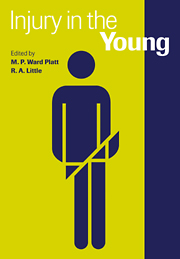Book contents
- Frontmatter
- Contents
- List of contributors
- Editors' Preface
- 1 The epidemiology of trauma involving children
- 2 Emergency room requirements for children
- 3 Child deaths in Accident and Emergency
- 4 Immediate life support
- 5 Evaluation of injury in children
- 6 Injuries of the developing brain
- 7 Wound healing in children
- 8 The lung after injury in children
- 9 Metabolic and endocrine stress responses to surgery
- 10 Head injury in children
- 11 Near drowning
- 12 The acute response to burn injury in children
- 13 Nutritional support of the severely burned child
- 14 Recovery, rehabilitation and the neuropsychological sequelae of head injury
- 15 Children's rights and child protection
- Index
2 - Emergency room requirements for children
Published online by Cambridge University Press: 18 September 2009
- Frontmatter
- Contents
- List of contributors
- Editors' Preface
- 1 The epidemiology of trauma involving children
- 2 Emergency room requirements for children
- 3 Child deaths in Accident and Emergency
- 4 Immediate life support
- 5 Evaluation of injury in children
- 6 Injuries of the developing brain
- 7 Wound healing in children
- 8 The lung after injury in children
- 9 Metabolic and endocrine stress responses to surgery
- 10 Head injury in children
- 11 Near drowning
- 12 The acute response to burn injury in children
- 13 Nutritional support of the severely burned child
- 14 Recovery, rehabilitation and the neuropsychological sequelae of head injury
- 15 Children's rights and child protection
- Index
Summary
Definition
In the USA and Canada the hospital department designated for receiving acutely ill or injured children is known as the Emergency Room: in the UK we are more familiar with the terminology ‘Accident and Emergency department’, although the term Emergency department alone is becoming more common. This chapter will look at the needs of children in the emergency department with particular reference to trauma.
Background: children in Emergency departments
Data identified by the Charity Action for Sick Children (Action for Sick Children, 1994) shows the following in the UK:
One-third of all patients seen in Accident and Emergency departments are children.
Approximately 3 million children per year attend Accident and Emergency and for many this is their first experience of hospital.
Children are more likely to be admitted to hospital as an emergency than in a planned way.
More than half the admissions of under 5 year olds into hospital are emergencies.
In the UK most emergency care is given to children in general Accident and Emergency departments which treat all age groups. There are nine specialist consultant-led paediatric Accident and Emergency departments in the UK and three in Eire.
- Type
- Chapter
- Information
- Injury in the Young , pp. 10 - 19Publisher: Cambridge University PressPrint publication year: 1998



